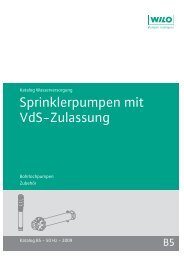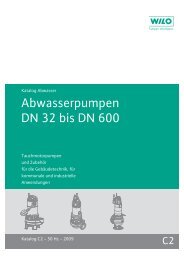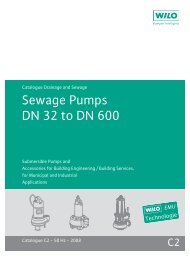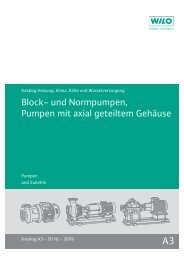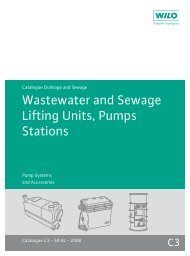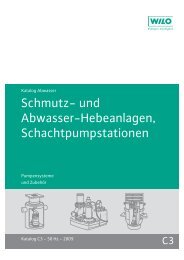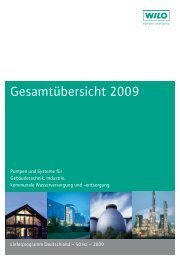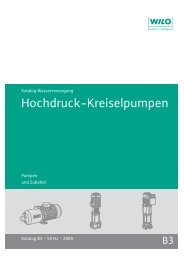Refrigeration, air-conditioning and cooling technology - 2007.pdf
Refrigeration, air-conditioning and cooling technology - 2007.pdf
Refrigeration, air-conditioning and cooling technology - 2007.pdf
You also want an ePaper? Increase the reach of your titles
YUMPU automatically turns print PDFs into web optimized ePapers that Google loves.
PLH_KKK_U2_31.QXP 25.05.2007 11:02 Uhr Seite 19Noises – Airborne sound –Structure-borne soundTo prevent or reduce potential bothersome noise, the pump operationin residential building systems requires special attention in theselection of suitable pumps / in the planning <strong>and</strong> execution of theinstallation.Especially in residential buildings, the problemof noise reduction plays a major role in comfortdem<strong>and</strong>s, especially during the night hours.For the permitted noise level value in commonareas, the following regulations are to be observed:• DIN 4109, Noise protection in building construction• VDI 2062, Vibration insulation• VDI 2715, Noise reduction in warm <strong>and</strong> hotwaterheater systems• VDI 3733, Noises in pipelines• VDI 3743, Emission characteristics of pumpsPumps as noise generatorsIt is unavoidable that pumps make noise. Wilo asa manufacturer is doing its best to deliver pumpswhich are as quiet as possible.In residential building systems, centrifugal pumpsare mostly used. The noise they make can basicallybe divided into the following main groups:Flow noiseThe flow noises have various causes. A noisehaving a large frequency range, which soundslike hissing, is caused by the turbulence <strong>and</strong>friction of the water particles on the surface ofthe parts being flowed through.Frictional processes also cause an irregular speeddistribution in the boundary layer, which can resultin alternating movements of the water flowoff the pipe wall causing subsequent turbulenceformation. This periodical vortex shedding createsa more or less pronounced single sound.Furthermore, the speed of the flow fluctuatesafter it leaves the impeller. These irregularitieslead to noise being generated in the connectedpipes. Since the frequency of these noises dependon the pump rotation speed <strong>and</strong> the numberof blades, one refers to the blade frequencyof the pump.Cavitation noiseThe cavitation noises in a pump are caused bythe formation <strong>and</strong> the sudden collapse of vapourbubbles in flowing water.Noise due to mass forcesVibrations, excited by mass forces, which lead tonoises, are caused by imbalances in rotating parts(impeller, shaft, coupling, etc.). Despite the mostmodern balancing <strong>technology</strong>, the imbalancecomes from alternating bearing forces, productionimprecisions or material wear or accretion.The frequency of imbalance vibrations is alwaysthe same as the rotational frequency of the rotatingparts.Noise due to friction on bearings <strong>and</strong> sealedplaces.Vibrations caused by friction on bearings <strong>and</strong>seals, which lead to noise, are not that importantwhen the pumps are working properly.Electromotor noisePumps are usually driven by electromotors in residentialbuilding systems. The noise which comesfrom the electromotor only belongs to the pumpnoise when the pump <strong>and</strong> electromotor are designedin a block. In the electromotor, sounds arecaused by electromagnetic processes at doublethe mains frequency (100 Hz) <strong>and</strong>, depending onthe number of poles, mostly between 600 <strong>and</strong>1200 Hz. Noise with a high frequency range isproduced by the fan of the motor, similar to thepump, which is superimposed with the blade frequencyof the fan as a single sound.Other noisesFurthermore, rolling noises from the ball bearingsas well as whistling noises on the dry-runningpacking gl<strong>and</strong>s <strong>and</strong> mechanical seals canoccur.Wilo Planning Guide - <strong>Refrigeration</strong>, <strong>air</strong>-<strong>conditioning</strong> <strong>and</strong> <strong>cooling</strong> <strong>technology</strong> 02/2007 19



